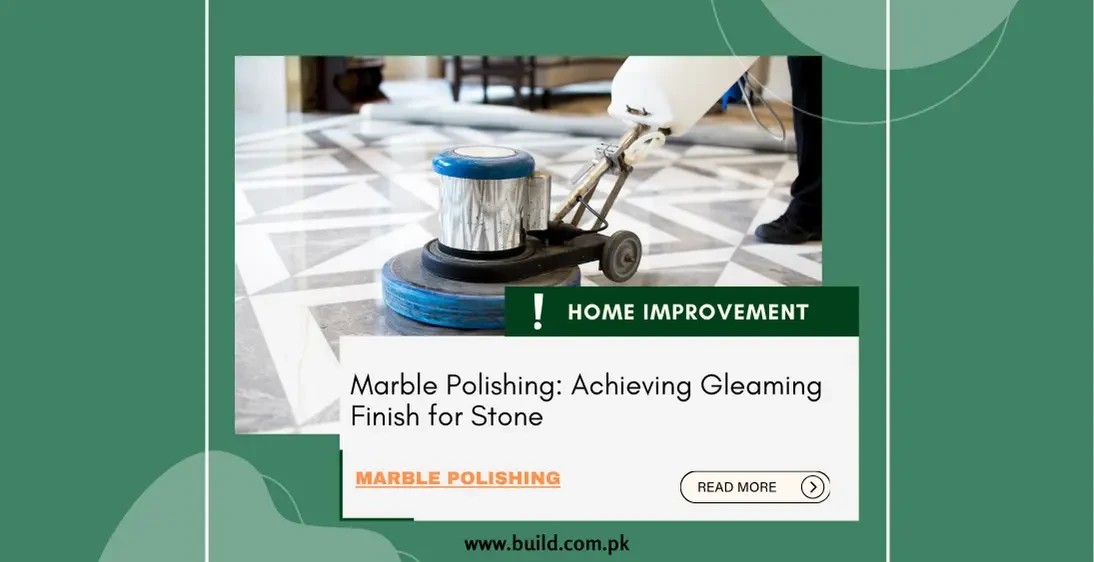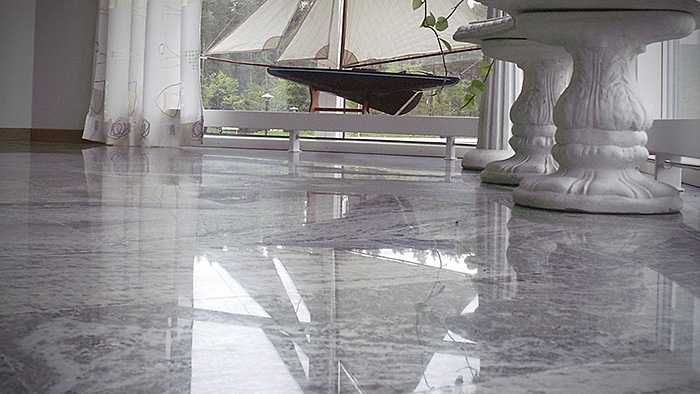Marble Polishing: Achieving Gleaming Finish for Stone

Introduction:
Marble
is synonymous with luxury, elegance, and timeless beauty. Its natural veining
and smooth surface make it a popular choice for floors, countertops, and other
surfaces in homes and commercial spaces. However, maintaining its pristine look
requires regular care and attention, with marble polishing being a key aspect.
This guide delves into the intricacies of marble polishing, including its
importance, methods, benefits, and maintenance tips to keep your marble
surfaces shining.
Understanding Marble Polishing
Marble polishing is the process of restoring the shine and smoothness of marble surfaces by removing scratches, etches, and stains. It involves several steps, including cleaning, honing, polishing, and sealing, to achieve a high-gloss finish that enhances the natural beauty of thestone.
Material Composition:
Marble is a metamorphic rock composed primarily of calcite, a form
of calcium carbonate. Its unique veining and patterns are the result of
impurities such as minerals and organic matter present during its formation.
These characteristics make marble both beautiful and susceptible to damage from
acidic substances, scratches, and wear over time.
Why Polishing is Necessary:
Over time, marble surfaces can become dull and
scratched due to foot traffic, spills, and regular use. Polishing not only
restores the surface’s shine but also helps to protect it from further damage.
Regular polishing maintains the aesthetic appeal of marble and extends its
lifespan by reducing the need for more extensive restoration work.
Methods of Marble Polishing
There are several methods to polish marble, each suited to different types of surfaces and degrees of wear. Understanding these methods can help you choose the best approach for your marble surfaces.
Grinding:
Pros:
Grinding involves using coarse abrasives to remove deep scratches and stains
from the marble surface. This method is highly effective for heavily worn or
damaged marble, as it can restore the surface to its original condition.
Cons:
Grinding can be a time-consuming and labor-intensive process. It also requires
specialized equipment and expertise, making it less suitable for DIY projects.
Honing:
Pros:
Honing uses finer abrasives than grinding to smooth the marble surface and
remove minor scratches and etches. This method provides a matte finish and is
ideal for areas where a high-gloss finish is not desired.
Cons:
Honing does not produce the same level of shine as polishing, which may be a
drawback for those seeking a glossy finish. Additionally, it may need to be
followed by polishing to achieve the desired look.
Polishing:
Pros:
Polishing uses progressively finer abrasives to achieve a high-gloss finish on
the marble surface. This method enhances the stone's natural colors and
veining, making it look new and vibrant. It also provides a smooth surface that
is easier to clean and maintain.
Cons:
Polishing can be less effective on heavily damaged marble and may require prior
grinding or honing. It also needs regular maintenance to sustain the shine.
Crystallization:
Pros:
Crystallization involves applying a chemical solution to the marble surface and
buffing it with steel wool pads. This method creates a harder, glossier surface
by chemically altering the stone's surface. It provides a long-lasting shine
and enhances the marble's resistance to scratches and stains.
Cons:
Crystallization requires the use of specific chemicals and equipment, which can
be cotly. Improper application can damage the marble, making professional
assistance recommended.

Benefits of Marble Polishing
Polishing marble surfaces offers numerous benefits beyond just aesthetic improvements. It enhances the durability, functionality, and overall value of the marble.
Enhanced Appearance:
Polishing brings out the natural beauty of marble, highlighting its
unique veining and colors. A polished surface reflects light, creating a bright
and welcoming ambiance in any room. The high-gloss finish can make spaces
appear larger and more luxurious.
Increased Durability:
Polished marble is more resistant to scratches, stains, and etches
caused by everyday use. The smooth surface is less likely to trap dirt and
grime, reducing the risk of surface damage. Polishing also strengthens the
stone, making it more resilient to wear and tear.
Ease of Maintenance:
A polished marble surface is easier to clean and maintain
compared to an unpolished one. The smooth finish prevents dirt and liquids from
penetrating the stone, making spills and stains easier to wipe away. Regular
polishing can minimize the need for extensive cleaning and restoration work.
Added Value:
Well-maintained marble surfaces can significantly increase the value of
your property. Polished marble exudes a sense of luxury and sophistication that
is appealing to potential buyers and tenants. Investing in regular polishing
ensures that your marble surfaces remain in top condition, enhancing the
overall value of your home or commercial space.
The Polishing Process
The marble polishing process involves several steps, each critical to achieving a flawless finish. Whether you're a DIY enthusiast or hiring a professional, understanding the process can help ensure the best results.
Preparation:
Cleaning:
Begin by thoroughly cleaning the marble surface to remove dirt, dust, and
debris. Use a pH-neutral cleaner to avoid damaging the stone. Allow the surface
to dry completely before proceeding.
Inspection:
Examine the marble for scratches, stains, and etches. Mark any areas that
require special attention. This step helps determine the level of grinding,
honing, or polishing needed.
Grinding and Honing:
Grinding:
If the marble has deep scratches or stains, start with grinding using coarse
diamond abrasives. Work in small sections, applying even pressure and using a
circular motion. Rinse the surface with water frequently to remove dust and
debris.
Honing:
After grinding, move on to honing with finer abrasives. This step smooths the
surface and removes any remaining imperfections. Continue working in small
sections, ensuring an even finish.
Polishing:
Polishing
Pads: Attach progressively finer polishing pads to a floor machine or hand
poliser. Start with the coarsest pad and work your way to the finest,
following the manufacturer’s instructions.
Polishing
Powder: Apply a polishing powder or compound specifically designed for marble.
Work in small sections, using a slow, steady motion to achieve an even shine.
Rinse the surface with water and wipe it clean with a soft cloth.
Crystallization (Optional):
Application:
If desired, apply a crystallization solution to the marble surface. Buff the
surface with steel wool pads to create a chemical reaction that hardens the
stone and enhances its shine. Follow the manufacturer’s instructions for best
results.
Sealing:
Sealer
Application: Once polishing is complete, apply a marble sealer to protect the
surface from stains and moisture. Use a clean cloth or brush to apply the
sealer evenly, allowing it to penetrate the stone. Wipe off any excess sealer
and allow the surface to dry completely.
Maintenance Tips for Polished Marble
Proper maintenance is crucial to preserving the shine and beauty of polished marble surfaces. Following these tips can help extend the life of your polished marble.
Regular Cleaning:
Clean your polished marble regularly with a soft, damp cloth and a
pH-neutral cleaner. Avoid acidic or abrasive cleaners that can damage the
surface. For tough stains, use a marble-specific cleaner and follow the
manufacturer’s instructions.
Spill Management:
ipe up spills immediately to prevent staining. Use coasters under
glasses and place mats under hot dishes to protect the surface. Avoid placing
acidic substances like lemon juice or vinegar directly on the marble.
Protective Measures:
Use rugs or mats in high-traffic areas to reduce wear and tear. Place
felt pads under furniture legs to prevent scratches. Avoid dragging heavy
objects across the marble surface.
Regular Polishing:
Schedule regular polishing sessions to maintain the shine and smoothness of your marble. Depending on the level of use and wear, this can be done annually or biannually. Professional polishing services can ensure the best results and extend the life of your marble suraces.
Conclusion:
Marble polishing is essential for maintaining the beauty and durability of your marble sufaces. Whether you choose to polish your marble yourself or hire a professional, understanding the process and its benefits can help you make informed decisions. By following proper maintenance tips and scheduling regular polishing sessions, you can ensure that your marble surfaces remain a stunning feature in your home or commercial space for years to come. Investing in marble polishing is an investment in the longevity and elegance of your stone surfaces









